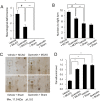Quercetin attenuates the reduction of parvalbumin in middle cerebral artery occlusion animal model
- PMID: 33632310
- PMCID: PMC7905853
- DOI: 10.1186/s42826-021-00086-0
Quercetin attenuates the reduction of parvalbumin in middle cerebral artery occlusion animal model
Abstract
Background: Calcium is a critical factor involved in modulation of essential cellular functions. Parvalbumin is a calcium buffering protein that regulates intracellular calcium concentrations. It prevents rises in calcium concentrations and inhibits apoptotic processes during ischemic injury. Quercetin exerts potent antioxidant and anti-apoptotic effects during brain ischemia. We investigated whether quercetin can regulate parvalbumin expression in cerebral ischemia and glutamate toxicity-induced neuronal cell death. Adult male rats were treated with vehicle or quercetin (10 mg/kg) 30 min prior to middle cerebral artery occlusion (MCAO) and cerebral cortical tissues were collected 24 h after MCAO. We used various techniques including Western blot, reverse transcription-PCR, and immunohistochemical staining to elucidate the changes of parvalbumin expression.
Results: Quercetin ameliorated MCAO-induced neurological deficits and behavioral changes. Moreover, quercetin prevented MCAO-induced a decrease in parvalbumin expression.
Conclusions: These findings suggest that quercetin exerts a neuroprotective effect through regulation of parvalbumin expression.
Keywords: Cerebral ischemia; Neuroprotection; Parvalbumin; Quercetin.
Conflict of interest statement
The authors declare that there is no financial conflict of interests to publish these results.
Figures



Similar articles
-
Quercetin Attenuates Decrease of Thioredoxin Expression Following Focal Cerebral Ischemia and Glutamate-induced Neuronal Cell Damage.Neuroscience. 2020 Jan 21;428:38-49. doi: 10.1016/j.neuroscience.2019.11.043. Epub 2019 Dec 23. Neuroscience. 2020. PMID: 31874239
-
Estradiol ameliorates the reduction in parvalbumin expression induced by ischemic brain injury.Neurosci Lett. 2014 Jun 27;574:36-40. doi: 10.1016/j.neulet.2014.05.006. Epub 2014 May 14. Neurosci Lett. 2014. PMID: 24831183
-
Ginkgo biloba extract (EGb 761) prevents the ischemic brain injury-induced decrease in parvalbumin expression.Lab Anim Res. 2012 Jun;28(2):77-82. doi: 10.5625/lar.2012.28.2.77. Epub 2012 Jun 26. Lab Anim Res. 2012. PMID: 22787480 Free PMC article.
-
Quercetin alleviates the injury-induced decrease of protein phosphatase 2A subunit B in cerebral ischemic animal model and glutamate-exposed HT22 cells.J Vet Med Sci. 2019 Jul 19;81(7):1047-1054. doi: 10.1292/jvms.19-0094. Epub 2019 May 16. J Vet Med Sci. 2019. PMID: 31092742 Free PMC article.
-
Quercetin attenuates neuronal cells damage in a middle cerebral artery occlusion animal model.J Vet Med Sci. 2018 Apr 27;80(4):676-683. doi: 10.1292/jvms.17-0693. Epub 2018 Mar 22. J Vet Med Sci. 2018. PMID: 29563391 Free PMC article.
Cited by
-
Apitherapy in Post-Ischemic Brain Neurodegeneration of Alzheimer's Disease Proteinopathy: Focus on Honey and Its Flavonoids and Phenolic Acids.Molecules. 2023 Jul 25;28(15):5624. doi: 10.3390/molecules28155624. Molecules. 2023. PMID: 37570596 Free PMC article. Review.
-
Polyphenols for the Treatment of Ischemic Stroke: New Applications and Insights.Molecules. 2022 Jun 29;27(13):4181. doi: 10.3390/molecules27134181. Molecules. 2022. PMID: 35807426 Free PMC article. Review.
-
Quercetin ameliorates glutamate toxicity-induced neuronal cell death by controlling calcium-binding protein parvalbumin.J Vet Sci. 2022 Mar;23(2):e26. doi: 10.4142/jvs.21273. Epub 2022 Jan 17. J Vet Sci. 2022. PMID: 35187882 Free PMC article.
-
Quercetin's Effects on Glutamate Cytotoxicity.Molecules. 2022 Nov 7;27(21):7620. doi: 10.3390/molecules27217620. Molecules. 2022. PMID: 36364448 Free PMC article. Review.
-
Intranasal delivery of mitochondria targeted neuroprotective compounds for traumatic brain injury: screening based on pharmacological and physiological properties.J Transl Med. 2024 Feb 16;22(1):167. doi: 10.1186/s12967-024-04908-2. J Transl Med. 2024. PMID: 38365798 Free PMC article. Review.
References
Grants and funding
LinkOut - more resources
Full Text Sources
Other Literature Sources

